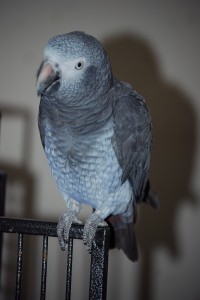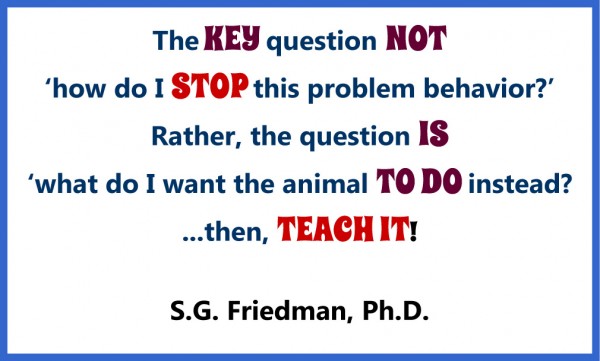Susan Friedman
Training: On Solving Pet Behavior Problems
Pet Dominance: Myth or Fact?
NOTE: I have a new pet behavior blog located at http://www.SoMuchPETential.com/blog. Thanks!
(This one of my past Hyde Park Living columns.)
Many unwanted behaviors like pulling on a leash, growling, barking, or biting are blamed on dominance. “They’ve got that alpha dog thing going on.”
Well, as Susan Friedman, Ph.D., has taught me, dominance is nothing more than a label for a behavior – a description of  what we as humans ‘think’ explains the problem behaviors we have with our pet. The problem is, a label is simply nothing more than an intangible explanation that doesn’t even specify what the observable behavior is or the condition in which it is behaved. Behavior plus conditions is the smallest meaningful unit of behavior analysis. And, unfortunately a label ultimately leads to a self fulfilling prophecy because how we react and how our animal responds to our actions leads to stronger behaviors. Giving behaviors labels stops us from our search for finding a positive solution for modifying that behavior.
what we as humans ‘think’ explains the problem behaviors we have with our pet. The problem is, a label is simply nothing more than an intangible explanation that doesn’t even specify what the observable behavior is or the condition in which it is behaved. Behavior plus conditions is the smallest meaningful unit of behavior analysis. And, unfortunately a label ultimately leads to a self fulfilling prophecy because how we react and how our animal responds to our actions leads to stronger behaviors. Giving behaviors labels stops us from our search for finding a positive solution for modifying that behavior.
How does the self-fulfilling prophecy come to play in talking about the alpha dog? Well, a couple months back I wrote about the dangers of using a technique called flooding (a form of training in which the animal is exposed to an aversive stimulus with no possibility of escape until the stimulus no longer arouses anxiety – labeled as dominance – in the animal). One claim is that you should force your puppy onto its back, not letting him up until he stops resisting. Some may say that is teaching your dog to be submissive but behaviorists will say that is creating learned helplessness, and if you are looking to build a strong, positive relationship with your dog – that is not the way to do it.
I digressed. So, this ‘alpha dog’ concept – it stems from studies of wolf packs in the 1940s. Dr. Ian Dunbar, founder of the Association of Pet Dog Trainers: 1) Those studies were short term and focused only on the most obvious facet of wolf life – mainly hunting. 2) Researchers observed what are now known to be ritualistic displays and misinterpreted them. 3) Researchers made some wild extrapolations from their data.
The fact is, dogs are to wolves what chimpanzees are to humans. They became a separate species well over 100,000 years ago. In that time there has been domestication, co-evolution with humans and selective breeding.
Behaviorists like my teacher and mentor Susan Friedman, Ph.D., and trainers who I’ve studied from such as Steve Martin, Barbara Heidenrich, and Susan Garrett instead focus on setting animals up for success. They look at the specific behavior to be modified or taught in terms of the purpose that behavior serves the animal in its environment. They reinforce behaviors they want to see. And they empower animals by putting the power of choice in the animal’s control and simply modifying the consequences (and/or the antecedents) to make the desired behavior the best choice.
So, let me recap. If you really want your dog to do what you want him to do, stop labeling him as dominant and stop using the excuse that he is a pack leader alpha dog. (Or that you have to be the alpha dog.) Instead, see yourself as a teacher and your dog as your student. Every unwanted behavior is an opportunity to teach a new skill.
Solving Problem Parrot Screaming
NOTE: I have a new pet behavior blog located at http://www.SoMuchPETential.com/blog. Thanks!
(a past Hyde Park Living column)
Screaming is one of those behaviors many bird owners complain about because they can’t seem to get the behavior to stop. And let’s face it…that noise isn’t exactly pleasant – at least to most of us.
Eleven years ago I was among the statistic of those who blamed Barnaby for making a noise I couldn’t live with. Just like so many other bird owners, I tried everything I had heard to try. I tried putting him in his cage, talking to him in quiet words, telling him “no”, ignoring him. All to no avail. I was at the end of my rope when I stumbled upon Susan Friedman, Ph.D. and her behavior teachings. Not only has my whole relationship with my pets changed as a result, she has sparked this passion in me to educate  others about using positive, scientifically proven strategies for modifying behavior.
others about using positive, scientifically proven strategies for modifying behavior.
What Susan teaches is that we’ve got to stop looking for answers by labeling behaviors or birds, or species generalities. It serves no purpose in helping to get at the root of the problem. The bottom line is that ALL behavior has function. No matter what the behavior is – whether it’s biting, not stepping up, chewing on furniture, or screaming – something occurred immediately prior to the act (antecedent) that may serve to “lead to” it, and something occurred immediately after the act (consequence) that impacts whether or not the behavior will be repeated in the future.
We, as teachers, can influence behaviors by changing the environment including antecedents and consequences.
All of my earlier attempts, I was taught, were actually reinforcing his screams – definitely why he had never stopped screaming. There’s a scientific word for what I had been doing. It’s called “intermittent reinforcement”, meaning, sometimes I gave him attention for screaming without even realizing it. Intermittent reinforcement make a behavior more resistant to change (think of the addiction of the slot machine in a casino).
My challenge as Barnaby’s teacher, was to provide him with a more stimulating and satisfying alternative to his screaming. In summary, it boiled down to three basic steps –
1) Ignore all screaming. Period. No attention at all, if I’m in the room, I calmly walked out with the other birds. With this step, I had to be prepared for an “extinction burst” where he screamed even louder to try to get my attention. Under no circumstances could I give in and go to him during this, or his problem would only worsen. The contingency I wanted Barnaby to learn was, “When” I scream “Then” the room is evacuated.
2) DRA or differential reinforcement of an alternative behavior. Each and every time Barnaby would make a chosen sound (at first it was a whistle, then changed it to “mommy here”), I was immediately there with reinforcement. The contingency I wanted Barnaby to learn with this was “When” I make this sound “Then” mom gives me attention. Eventually I got to where I don’t come each time, sometimes I’ll tell him I’m busy.
3) Thoughtful arrangement of the environment. I needed to make sure Barnaby had enough activities that HE was interested in to keep him busy. When I left his room, in the beginning, I would give him something to keep his mind occupied until I was out of sight. If he wasn’t interested in what I had given him, it meant that his gift wasn’t as stimulating to him as calling out to me, and so I had to find something else that was.
It has now been ten years since I first started learning about this. And I’ve got quite a little chatter box in my home. People ask me why Barnaby talks so much and I tell them it is because he gets attention when he talks. When he screams he gets no attention.
Of course there are still moments when the birds scream, they are, after all birds. But it is more the exception than the rule now.















